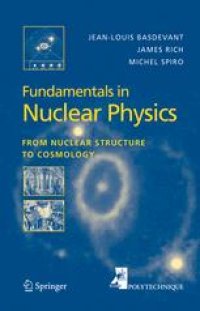
Ebook: Fundamentals In Nuclear Physics: From Nuclear Structure to Cosmology
- Tags: Nuclear Physics Heavy Ions Hadrons, Astronomy Astrophysics and Cosmology, Astronomy, Astrophysics, Nuclear Fusion
- Year: 2005
- Publisher: Springer-Verlag New York
- Edition: 1
- Language: English
- pdf
This course explores nuclear physics and its applications ranging from the structure of nuclei and their reactions, to astrophysics and cosmology. The physics is introduced with arguments based on simple ideas such as the empirical structure of nuclear forces and its interplay with the Pauli principle and Coulomb repulsion. The book then develops elementary nuclear models and illustrates nuclear systematics with experimental data. Reactions and decays are discussed both phenomenologically and from the point of view of fundamental electro-weak interaction theory. The discussions of fission and fusion emphasize nuclear energy production. This leads directly into nuclear astrophysics and nucleosynthesis. The book ends with a presentation of the latest ideas about cosmology. As a primer this course will lay the foundations for more specialized subjects within the vast domain of nuclear physics as a whole.
This book emerged from a series of topical courses the authors delivered at the Ecole Polytechnique and will be useful for advanced undergraduates and for scientists in a variety of fields.
This course explores nuclear physics and its applications ranging from the structure of nuclei and their reactions, to astrophysics and cosmology. The physics is introduced with arguments based on simple ideas such as the empirical structure of nuclear forces and its interplay with the Pauli principle and Coulomb repulsion. The book then develops elementary nuclear models and illustrates nuclear systematics with experimental data. Reactions and decays are discussed both phenomenologically and from the point of view of fundamental electro-weak interaction theory. The discussions of fission and fusion emphasize nuclear energy production. This leads directly into nuclear astrophysics and nucleosynthesis. The book ends with a presentation of the latest ideas about cosmology. As a primer this course will lay the foundations for more specialized subjects within the vast domain of nuclear physics as a whole.
This book emerged from a series of topical courses the authors delivered at the Ecole Polytechnique and will be useful for advanced undergraduates and for scientists in a variety of fields.
This course explores nuclear physics and its applications ranging from the structure of nuclei and their reactions, to astrophysics and cosmology. The physics is introduced with arguments based on simple ideas such as the empirical structure of nuclear forces and its interplay with the Pauli principle and Coulomb repulsion. The book then develops elementary nuclear models and illustrates nuclear systematics with experimental data. Reactions and decays are discussed both phenomenologically and from the point of view of fundamental electro-weak interaction theory. The discussions of fission and fusion emphasize nuclear energy production. This leads directly into nuclear astrophysics and nucleosynthesis. The book ends with a presentation of the latest ideas about cosmology. As a primer this course will lay the foundations for more specialized subjects within the vast domain of nuclear physics as a whole.
This book emerged from a series of topical courses the authors delivered at the Ecole Polytechnique and will be useful for advanced undergraduates and for scientists in a variety of fields.
Content:
Front Matter....Pages I-XIII
Introduction....Pages 1-7
Basic concepts in nuclear physics....Pages 9-66
Nuclear models and stability....Pages 67-106
Nuclear reactions....Pages 107-173
Nuclear decays and fundamental interactions....Pages 175-243
Radioactivity and all that....Pages 245-283
Fission....Pages 285-328
Fusion....Pages 329-350
Nuclear Astrophysics....Pages 351-396
Nuclear Cosmology....Pages 397-439
Back Matter....Pages 441-515
This course explores nuclear physics and its applications ranging from the structure of nuclei and their reactions, to astrophysics and cosmology. The physics is introduced with arguments based on simple ideas such as the empirical structure of nuclear forces and its interplay with the Pauli principle and Coulomb repulsion. The book then develops elementary nuclear models and illustrates nuclear systematics with experimental data. Reactions and decays are discussed both phenomenologically and from the point of view of fundamental electro-weak interaction theory. The discussions of fission and fusion emphasize nuclear energy production. This leads directly into nuclear astrophysics and nucleosynthesis. The book ends with a presentation of the latest ideas about cosmology. As a primer this course will lay the foundations for more specialized subjects within the vast domain of nuclear physics as a whole.
This book emerged from a series of topical courses the authors delivered at the Ecole Polytechnique and will be useful for advanced undergraduates and for scientists in a variety of fields.
Content:
Front Matter....Pages I-XIII
Introduction....Pages 1-7
Basic concepts in nuclear physics....Pages 9-66
Nuclear models and stability....Pages 67-106
Nuclear reactions....Pages 107-173
Nuclear decays and fundamental interactions....Pages 175-243
Radioactivity and all that....Pages 245-283
Fission....Pages 285-328
Fusion....Pages 329-350
Nuclear Astrophysics....Pages 351-396
Nuclear Cosmology....Pages 397-439
Back Matter....Pages 441-515
....